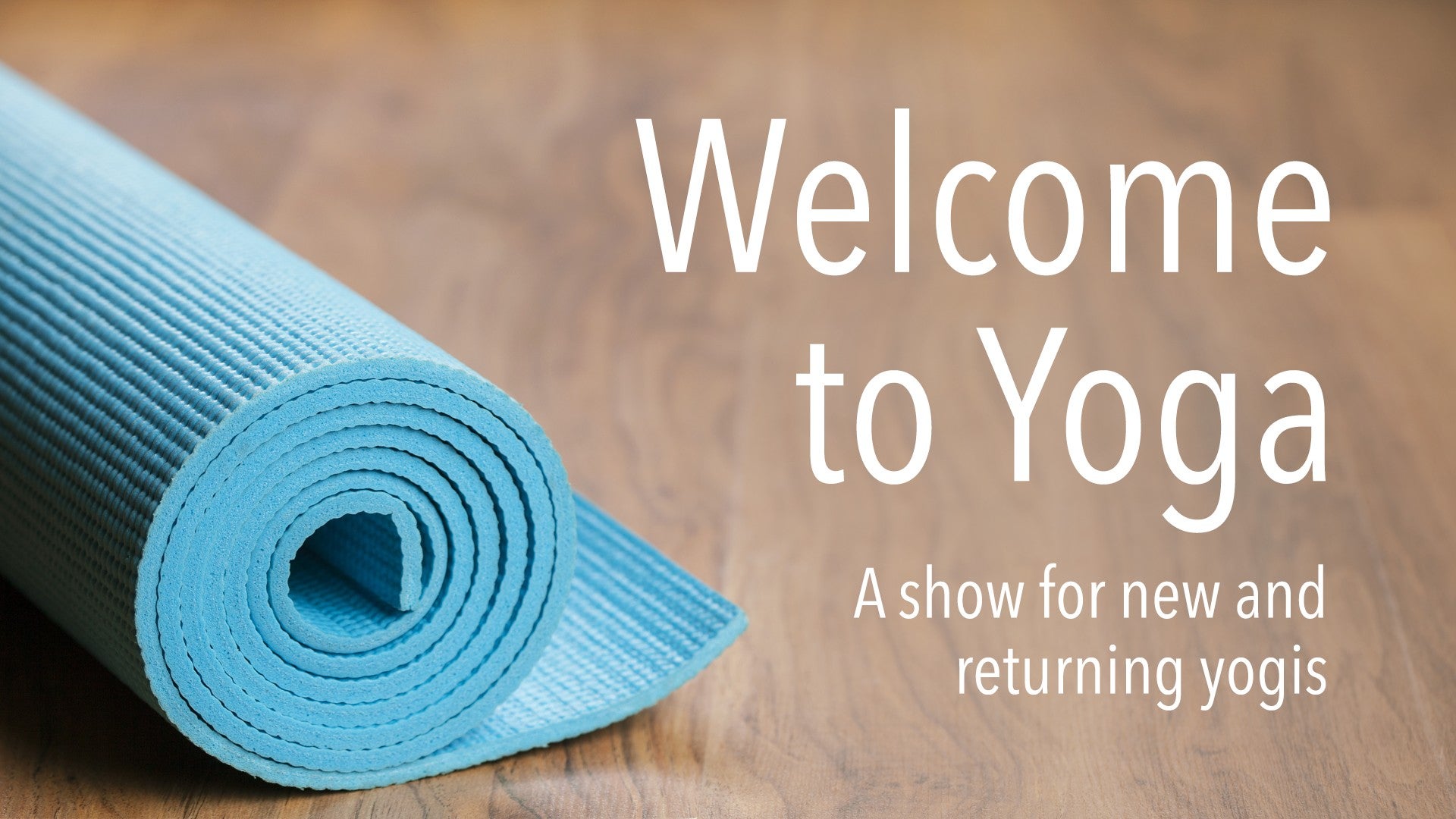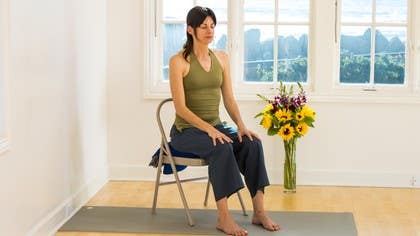Description
About This Video
Transcript
Read Full Transcript
(waves gently crash) Hello and welcome. Take a moment to find a way to sit that works for you. I have a tutorial on different options, and I'm opting to sit in perhaps the most accessible. Definitely the most accessible way to sit up on a chair, but if you wanna sit any other way, it's fine. This is a practice about releasing tension in the neck.
I recently did a poll of my students in San Francisco and I kept asking people, "Who doesn't have neck pain?" Classes, class after class, I couldn't find a person for like three weeks that didn't have some sort of neck tension, so this is deep in out culture, and one of the reasons it's deep in our culture, I'm just gonna turn to the side, is because in this day and age of screens, the head goes forward often, the shoulders stay back, and without having the head over the shoulders, the neck has to work really hard to keep the head up. If we can get our head back over our shoulders, then the neck doesn't have to grip so tightly. So the first thing we're gonna do is something I learned from Lilias Folan who when I was eight or nine years old, 40 years ago, she was on TV in these cool unitards, on PBS and she would teach yoga, and I was mesmerized, at a young age about that. So I think she's still going. I took a workshop with her about six or seven years ago and I learned this sequence that stuck with me.
So first we look forward and we keep our shoulders even, and just look to the side. We're taking a little snapshot of how much mobility we have in our neck. So we're looking to the right and then bring your head back to the center, and just remember how far you can turn your head. And then take your right arm across your body, and scoop it up with your left arm. Descend your right shoulder down and draw your right arm in.
And now, as you inhale, you're gonna press your right arm into your left arm really firmly, like you're trying but you're not gonna do this, but you're trying to do something like that. But this arm, the left arm is blocking it. So you press as you inhale, and then if you exhale, soften the shoulder and draw the arm in. And then again, press the right arm into the left arm. As you exhale, let the arms soften in towards the chest.
Two more. Inhale, strong, muscular action. Pressing the right arm into the left. As you exhale, soften, drawing the right arm across, remembering to descend the right shoulder. Last time, inhale, press.
And exhale, soften and draw in. And then release that with your left hand, find your upper trapezius muscles, right in the side of your neck and squeeze them, like you're juicing a grapefruit. Really give them a good, strong squeezing. Feels almost as good as getting a professional massage. Maybe.
And then make a gentle fist with your left hand, and just pound on those muscles. Make sure your head is out of the way. Do a strong but gentle pound without damaging yourself. Feel like you're just whipping out any unnecessary tension in those upper trapezius muscles that feed in towards the neck. And then release that, and then we get to take our after shots, so you turn your head.
And, woo, I got a lot more range of motion with the second side. Turn your head to the left. Notice how much range of motion you have. And then bring your head back to the center. Left arm crosses in front.
Right arm scoops up. Descend the left shoulder and draw the left arm in. And here we go with our pressure and the breath. Inhale, left arm presses into the right arm. And as you exhale, right arm draws the left arm in.
Feel free to close your eyes to help you drop more into your body and feel what you're feeling. Inhale, left arm presses into the right. Exhale, right arm pulls the left in. Inhale, you push. Exhale, you soften.
Inhale, push. Exhale, soften. And then release that right hand. Grabs these muscles at the base of the neck and squeeze them. Really feel the sensations that you're giving yourself.
Feel those muscles. You can notice if they feel gushy or like rocks underneath your hand and any way that you find yourself is just fine. And then gentle pounds with the hand. Let the fist be loose as you do this. Your right fist.
And release and again turn your head to the left, and notice if you have more mobility. Right ear's gonna drop straight down towards the right shoulder. So you can keep your rib cage balanced. It's tempting to let the whole upper chest go to the side, but keep the shoulders even, collar bones open and just let your right ear be heavy. Imagine there's water or sand just falling out of your right ear across your right shoulder.
And then from here, slowly without dropping the lift of the chest, roll your chin down towards your chest. Let it come just to the center. Pause there. And let your head come right up in the center. Check the alignment of your head.
Make sure it's not forward and computer mode. Have it right over your chest, and the left ear straight to the left shoulder Keeping the right collar bone broad. Keeping both shoulder blades descending evenly. And then feel these long muscles that connect from underneath your shoulder. I'm sorry, underneath your ear out into your shoulder.
Watch them if they slowly stretch like taffy. Keeping the chest lifted. Moving slowly, roll your chin down to your chest. This time, keep your head going. Let it roll all the way over to the right.
So the right ear is drooping down to the right shoulder, and then we're gonna turn the head so the nose is now gonna go down in the direction of your shoulder, opening some muscles that are further in the back of the neck. From here, slowly, slowly roll your chin towards your chest. Come over to the other side. First the left ear, dropping straight down towards the left shoulder. Not in front of it, get it all the way, head all the way to the side so the ear is drooping straight down.
And then turning the head, notice how the sensation shifts back in the neck. And then from here, let your chin come down to your chest. And lift your head, circle your shoulders around three times. One, two, three. And then just for the next minute or so, let your head move around in those areas that we've explored.
We're gonna avoid for now, taking the head back, because it's easy to crunch into the back of the neck, which isn't such a great thing to do. So we're just gonna explore the forward and the side space. And I would like you, if you find a place that feels particularly gripped, to pause in that place, and to breathe in that place. Give the tight parts some time to open and catch up to the looser parts. In order to do this, you have to be like an explorer in your own neck, noticing where there's darkness.
And getting out your flashlight and trying to shine some light where there's darkness. And then let your head find its way back up. The head stacked right over the chest. The ears dripping right down to the shoulders. And then you should notice how your neck feels.
Hopefully there's a little more freedom. Maybe feeling that your head is just gonna float up like a helium balloon, away from the rooting of your pelvis. And then just one more thing I wanna address is so many yoga practices take the arms up overhead, and it's easy to tense the neck when the arms go up overhead. So I want you to be especially mindful from here on up, for the rest of your life, about not overworking your neck when you lift your arms up overhead. So take your arms somewhere on the diagonal, and begin to lift your arms up overhead, and notice when your neck starts to kinda grip, and in that place, stop, pause, soften.
Soften your shoulders. Maybe turn your head a little bit from side to side. And then maybe your arms come up higher. Maybe not. It's easier on the neck and the shoulders and everything to have the arms either stay wider, and or stay more forward.
So whenever you're doing a practice and you are asked to lift your arms, feel free to not bring them up and press the palms together if that tenses your neck. Over time, you might be able to find freedom in your neck, and bring the arms up overhead, but until that time, just go, explore, find places where you can keep a nice, happy, free throat and neck. The neck links our brain to our heart. It's a very integral place. Thank you very much.
Namaste.
Welcome to Yoga: Explore the Fundamentals
Comments
You need to be a subscriber to post a comment.
Please Log In or Create an Account to start your free trial.

















